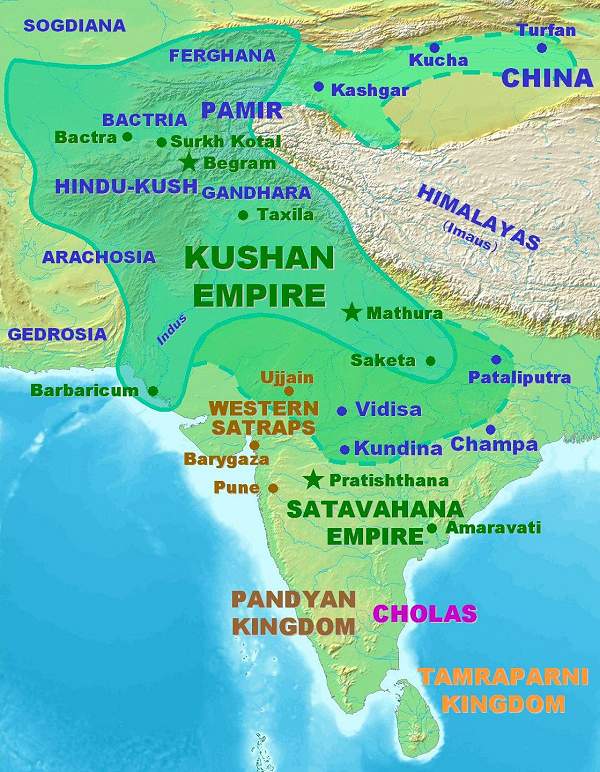Volume One
Ancient and Medieval States
Background
The Saka Peoples
The Saka were nomadic peoples who had been driven from their homelands around 130 BC by the arrival of the Zuezhi, an Indo-European people that had themselves been displaced from the Gansu corridor by Mongol peoples some time around 170 BC. The Saka were called Scythians by the Greeks, and seem to have been Iranian-speaking Indo-European nomads who deployed chariots in battle, sacrificed horses, and buried their dead in barrows or mound tombs called kurgans. The migrations came in overlapping waves, probably more complexly than is recorded by their coinage, in which there is much borrowing and amalgamation of styles. Each group emerges into history as they strike coins whose similarities may nonetheless conceal differences in languages and social customs.
These tribal migrations had a profound effect on surrounding countries. 'Barbarian' hordes hastened the end of the western Roman Empire, and, in settling, became the forebears of modern Europe and so America. China was invaded by the Jin tartars, the Mongols and the Manchus. In India the Saka settlements were followed by the empires of the Delhi Sultans and the Mughals.
The Kushans: Huvishka I: Gold Coinages
Most left their record of conquests and splendid courts on literate peoples, so that numismatic evidence only supplements what is known from other sources. Rather different is the situation with the Saka peoples, however, whose abundant and varied coinage is the main source of information we have of them. Many rulers, like those of the Indo-Greeks, are indeed only known through their coinage, and then not with certainty: many attributions are still contested, despite extensive work in recent years.
The Indo-Greeks struck occasional gold coins during their two centuries of rule in northwest India, {1} but the styles are a continuation of the Greek stater rather than a proto-dinar as such. The abundant silver and base metal coinage of the succeeding Indo-Scythians shows a lively depiction of ruler and deities but by western standads the sheer beauty of the Greek issues is missing, and indeed the artistic quality gradually falls off {2} during their 2nd century BC to 4th century AD rule over north-west India and Afghanistan.{3} Quality improves in the Kushan coinages but the images again lack the Greek modelling in the round, that splendid combination of freedom and compactness. {4}.
Kushans (60-375 AD)
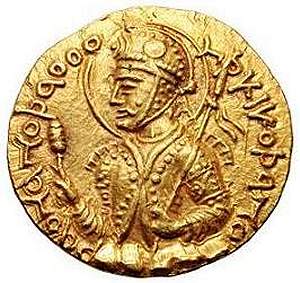 | The Yuezhi, an indo-european nomadic people inhabiting part of Kansu until 174 BC (when they were driven out by the Hiung-nu or Huns), conquered Bactria in the 2nd century BC and divided the country into five chiefdoms, one of which was the Kushans. {5-11}. Under Kaniska I and his successors, the Kushans became one of the four great Eurasian powers, ruling over most of the northern Indian subcontinent, Afghanistan, and parts of central Asia. {12-16} |
Gold Dinar of Huvishka I. (AD 260-292). Weight 7.94 gm. Obverse: nimbate, diademed bust of king left on cloud, holding mace in right hand and filleted spear over left shoulder. | The Kushans helped spread Buddhism in central Asia and China, encouraging Mahayana Buddhism and patronizing the Gandhara and Mathura schools of art. {12-16} |
The Kushans became affluent through trade, particularly with Rome, and their large issues of gold coins show Greek, Roman, Iranian, Hindu, and Buddhist deities, and bear inscriptions in modified Greek letters (Scythic Greek), bearing witness to their toleration and religious syncretism. The Kushans were superseded by the Sasanian dynasty in Iran and by local powers in northern India. {12-16}
 | Much of what we know about the Kushans comes from their coins, which follow the styles of the preceding Greco-Bactrian rulers: a Hellenistic image of the king on one sider and a deity on the other. Roman mint influences appear in later issues, where the gold is also debased with silver. The gold probably came from trade with the Roman empire, which, according to Pliny, poured out specie payments annually of 100 million sesterces to India, Arabia and China for luxury items like silk, pepper, muslin and gems. {15} |
Reverse: pharro, nimbate and wearing winged petasus, standing left, extending right hand above tamgha and resting left hand on staff. Göbl 206. {2} | Many coins bear the individual royal symbol or tamgha, which appears on the reverse of the coin here. {15} |
Scripts
The early coins used the Kharosthi script, and the later ones a modified Greek — Scythic Greek, where the letter forms are altered and an extra letter added: p denoting 'Sh' . The Kharosthi can be difficult to read. The T D R B and N all look rather similar, allowing words to be transliterated in several ways. Kharosthi was introduced into the Afghanistan and north-west India in the early part of the 5th century BC as a result of the eastward spread of the Persian Empire, and derives from Aramaic, retaining its Semitic source by being read from right to left. Kanishka used good Greek, but this is modified into Scythic Greek ( read from left to right) under later rulers. The very last rulers, more Kushan chieftens, employed Brahmi. {12} The obverse inscription in the coin above is in Scythic Greek and reads 'King of kings' (pAONANOpAO) 'Hunishka' (OOepKI) ' the Kushan' ( KOpANO). {17-20, 35}
Eclectic Nature of Indian Culture
Early Indian numismatics is a difficult field. {21} For centuries some areas had no coinage at all. The coins that do appear often lack inscriptions, and supporting evidence for dynasties and local rulers is generally limited to temple inscriptions, reports of travellers, and religious texts not over-concerned with this passing world of shadows. Indian religion was not rigidly doctrinal, moreover, but based on community, prayer and ritual. Under the Kushans, originally animalists and perhaps content to see the life-spirit assume different forms in different peoples they had conquered, that contentment became religious toleration. Indeed, if they encouraged any religions at all, it was Buddhism, {24} where the world is seen as a delusion: exactly what would make a subject people more accepting of a foreign yoke. Monasteries and secular buildings were often lavishly decorated, {35}
Nonetheless, as new dynasties commonly do, the Kushans emphasized their legitimacy by supporting local customs and patronizing the arts. The Greek language continued to be used, at least for administration, and there was much borrowing of words between Greek and Indian languages.{18}
The fluid or eclectic nature of early Indian religion and art is also found in its coinage. {22}
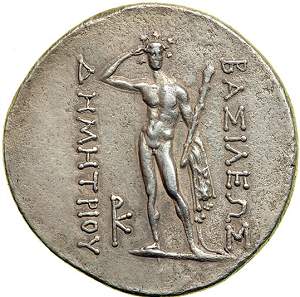 | 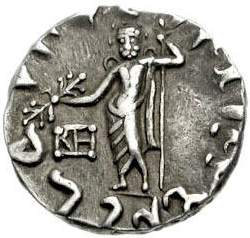 | 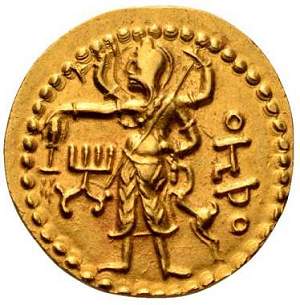 |
Bactria: Demetrios I (200-185 BC) Ar Tetradrachm reverse: Herakles standing facing, holding club and lion skin in left hand,and crowning himself with his right hand BAΣIΛEΩΣ ΔHMHTPIOY monogram in lower left field. {3} | Indo-Scythians: Vonones (c. 100-90 BC) Ar Tetradrachm reverse: 'Maharajabhrata dhramikasa Spalahorasai' in Karosthi. Zeus or Herakles standing facing holding thunderbolt and leaning on sceptre. KHI monogram in left field. (MIG 682; Whitehead 372). {4} | Kushans: Huvishka (AD 152-192) Au Stater or Dinar reverse: OKPO, Shiva, nimbate, standing left, pouring water from flask and holding thunderbolt, elephant goad, trident, and he-goat or antelope by the horns; tamgha in left field. (BMC 97-99; MK 308; Cunningham 89). {5, 35} |
Numismatic authorities, even Indian ones, {29} are often inclined to see artistic excellence through western eyes. Quality in coinage thus declines from Indo-Greek standards, picks up a little in the Kushans, a little more in the Guptas, and makes a final flourish in some of the more splendid Mughal issues. But it may be wiser to use aesthetic standards that distinquish between different life views. The Demetrios piece above is a masterpiece of numismatic art — no one has ever doubted that — but also represents a peculiarly Greek view of man's place in the world. Under the Indo-Greeks, the city states became small kingdoms, partly adopting the Buddhist faith, and thereby cut off from Mediterranean events, indeed being surrounded by hostile powers: the restive steppe peoples to the north and native Indian kingdoms to the south. That vulnerability we can sense in this coin with its empty spaces on the flan, the legend not integrated with the figure, and with Heracles crowning himself. Greek art is an idealisation, moreover, where the human body, usually displayed in its unclothed form, is the foundation of all beauty and proportion. Balance and mathematical order underlie these conceptions, and art is created for the joy of the spirit, or the simple animal happiness of being alive. That isolation or defiance of local events — Heracles has succeed against all odds — is everwhere present in this idealisation: it is beautiful, but unreal.{30}
The Indo-Scythian coins introduce some new motifs, notably obverses with the king on horseback, and various deities on the reverse. And, as if to represent their dual world, the obverses bear Greek legends and the reverses Karosthi ones. But now the figure, Heracles or Zeus, is not an idealisation of the human form, and is not replendently naked but wears a waist-high robe. His is not an elegant figure, moreover, but has something of the willowy Korosthi characters.
Different again is the Kushan coin, where Heracles has become Shiva, a process that can be documented in temples and temple inscriptions. {22} The nimbused and four-armed Shiva is wearing trousers, possibly those of the steppe nomads, and he is holding various objects of Indian significance. The monogram has become the tamgha. More importantly, Shiva's depiction is integrated into the other features of the coin, including the beading. Kanishka, the first great Kushan ruler, adopted deities with Greek names and iconographic forms: Helio, Salene and Hephaistos. But he soon replaced Greek on his reverses by Scythian Greek, and introduced a host of male and female deities with Iranian names: Mithra (sun), Mao (moon), Oada (wind) Athsho (fire), Nania (nature goddess), Ardocksho (counterpart of Lakshmi), the Buddha and so on. Why? To appease his subjects, to extend an animalistic mythology, to play safe with all heavenly powers, or to emphasise the international nature of his empire? We can only speculate, though the process is a common one in folk tales and local mythology, {26-28} and one congenial to the syncretic Indian mind that dislikes the rigid doctrinal divisions of the Islamic and Christian faiths.
But we shouldn't overdo the contrast. Buddhism split into several schools and many sects, often mutually antagonistic. Nor was Buddhism ever a simple contemplation or mindless reverie: the literature is vast, and the Chinese repeatedly sent missionaries to obtain authentic writings from India. Buddhist monasteries engaged in large-scale lending, moreover, becoming extremely wealthy and indeed powerful — when they were often despoiled or suppressed by indigent rulers, in India and China.{23-24}
What was Kushan society like? We don't know. Most of our knowledge of the Kushan rulers comes from their abundant coinage, and the few contemporary accounts are not flattering. The Kushans were called a brutal lot — formidable in warfare, prosperous from agriculture and trans-Asian trade, but negligent in religious duties. {18} If the later Mongols and Delhi Sultans are any guide, the Kushans may have remained a military elite, perhaps even speaking their own language (about which there is much debate), and only gradually succumbing to local customs. So were the Normans in England, of course, and the Manchu in China. But gradually the two classes coalesced, each learning from the other, and the elite coming to appreciate and adopt the laws, customs and beliefs that had governed the country for centuries previously.
Azes I Tetradrachm and the Indo-Scythians

The Indo-Scythians are another of the Saka tribes, {36-7}, numismatically important, but about whom we otherwise know very little. {48-9} As they affect India, the histories — greatly simplified {40, 42-3} — are as follows:
The Sakas advanced into the Indo-Greek kingdoms of Bactria around 80 BC, though pockets of these Indo-Greek peoples persisted, and for decades continued to issue coins.
The first group of Sakas known through their coinage is called the Vonones-Maues and Azes group, and probably flourished from about 80 B.C. to their end under Azes II around AD 20 (if Azes II in fact existed: some now doubt this).
The second group, led by Gondophares, conquered the empire of Azes II and took over areas of the Kabul valley from the Kushan Kujila Kadphises. They ruled Afghanistan, Pakistan and north-west India for much of the first century AD, and are usually called the Indo-Parthians. Their coinage is influenced by Parthian models, but there is little evidence that they were otherwise related.
The most powerful of the Saka empires were the Kushans, who ruled north-west India and surrounding areas between A.D. 60 and 300. Among their rulers was Vima Takto, long known to numismatists as 'the nameless king' since his coins only showed the legend 'King of Kings, Great Saviour (Soter Megas), until the discovery of the Rabatak inscription helped connect his name with coin titles. Vima Takto's empire covered north-western Gandhara and greater Bactria towards China, to which he sent embassies..
The Kshatrapas or Western Satraps also owe their origin to Saka peoples but use Brahmi on their coins rather than the Kharosthi of the Indo-Scythians and Kushans. Their 1st to 4th century rule ended when they were defeated by Chandragupta II and their lands absorbed into the Gupta Empire.
To further complicate a confusing picture there are the Kushano-Sasanids or Kushanshas (also called Indo-Sasanians), who were a branch of the Sasanid Persians that pushed out the Kushans in north-west Pakistan during the 3rd and 4th centuries. They were in turn displaced in 410 by the invasions of the Huna people, but were to re-establish themselves after the Sasanids defeated the Hephthalites in 565.
Finally, around AD 408, another tribal people arrived and occupied parts of Afghanistan, Turkmenistan, Uzbekistan, Tajikistan, Kyrgyzstan, Kazakhstan, Pakistan, India and China. These are the Hephthalites who, in kinship or alliance with peoples called Huna (or White Huns), made serious inroads on the Sasanian and Gupta territories before being expelled to their northern tribal lands around A.D. 670. {1-2}.
The Indo-Scythians (80 BC - AD 20)
 | The Indo-Scythian coins adopt features of the later Indo-Greek coinage, notably the Buddhist symbolism where divinities form the vitarka mudra with their right hand, or introduce the Buddhist lion. In addition, kings are commonly shown on horseback, either in armour or wearing nomadic tunics. Contemporary Gandharan sculptures also show foreigner in soft tunics, sometimes wearing the typical Scythian cap. These are very different from representations of Kushan kings, moreover, who wear thick, rigid tunics, represented in a more simplistic manner. {3} |
Indo-Scythians. Azes I, AR Tetradrachm, 58-20 BC. 9.63 g. Taxila mint. BASLIEWS BASILEWN MEGALOU AZOU in Greek (Great King of Kings Azes) around Zeus standing left, holding transverse sceptre and raising right hand. | The Indo-Scythians occupied parts of the silk route, along which travelled not only trade but Buddhist missionaries from China. Indeed there was a cross-fertilisation, and even from archaeological sites much further north, in Khotan, for example, come Roman seals and intaglios, Indo-Scythian coins and Greco-Buddhic frescoes. {2} |
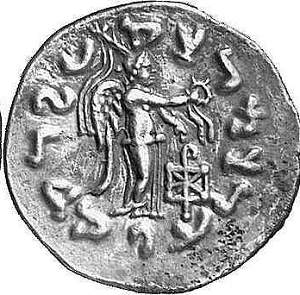 | Indo-Scythian coins commonly use Greek for the obverses and Kharosthi for their reverses. Part was no doubt a continuation of Indo-Greek traditions, which blended Hindu, Buddhist and ancient Greek customs and religious practices, The Indo-Greeks were particularly prosperous, farming rich agricultural lands and adopting not only Greek technologies but Chinese too in metal-working. {4} Kharoshti in fact postdates Brahmi, but derives from Aramaic, being intoduced into north-west India from the Achaemenid Empire in the 5th century BC. {5} It may well have been the language of Indo-Greek administration, the Greek being retained for ritual purposes. |
Reverse: MaHaRaJaSa RaJaDIRRaJaSa AYaSa in Kharosthi (Great King Azes) around Nike standing right, holding fileted wreath and palm branch. RPUD monogram in field. (Bop. Series 8A; Mitchiner MIG 729a.) | Greek deities appear on the reverses, but there are also Indian elements: elephants, bulls and Indian deities. Gandhara art, a fusion of Greek and Indian traditions, is commonly attributed to the Indo-Scythian period, but some may be earlier. {4} |
The advance of Maues into Indo-Greek territories seems to have been gradual and largely peaceful, moreover, the two territories being cemented by marriage alliances and continuing to strike their own coinages. {5}
The Indo-Parthians (12 BC - AD 130)
Much is uncertain or conjectural about the Indo-Parthians, history being largely based on their coinage, but the kingdom seems to have begun with Gondophartes I, a minor chieften in eastern Iran who conquered parts of the Kushan empire and the Indo-Scythian kingdom in Afghanistan, Pakistan and north-west India after the death of their Azes II. Unlike the Indo-Scythians, the Indo-Parthians were Zoroastrians in religious orientation, but seem otherwise to have been similar, depending on agriculture and trade. Coins struck in the western areas of rule, in Seisten, follow Parthian models, but those in other areas are similar to the Indo-Scythian issues, employing Greek and/or Kharosti, the latter having some peculiarities of script. Abdagases, the successor to Gondophares, lost much of his uncle's conquests to the Kushans, and later rulers were largely confined to Seistan. {9-10}
The kingdom after Gondophares may have resembled a loose affiliation of rulers more than centralised government, and five distinct areas can be numismatically identified.{10} Sanabares was an ephemeral usurper in Seistan, for example who employed only Greek on his coins, {11} perhaps to assert his dubious legitimacy. Like the Indo-Scythians, the Indo-Parthians issued coins in silver and base metals, but Abdagases II also struck gold for presentation purposes. {10}
The Kshatrapas
The Kshatrapas were a fairly distinct and long-lived kingdom around Gujarat that saw 27 rulers over 350 years. Their kings may have been vassals of the Kushans, or remained in friendly alliance with them. The coins initially use Kharoshthi, Brahmi and Greek script, but later only Brahmi, together with pseudo-Greek script to convey the Prakrit language employed by the Kshatrapas. A few legends are in Sanskrit. {18} There was much trade with Rome, and traveller's tales happily provide some local colour that is largely missing from other Saka societies: {19}
'There are imported into this market-town (Barigaza), wine, Italian preferred, also Laodicean and Arabian; copper, tin, and lead; coral and topaz; thin clothing and inferior sorts of all kinds; bright-colored girdles a cubit wide; storax, sweet clover, flint glass, realgar, antimony, gold and silver coin, on which there is a profit when exchanged for the money of the country; and ointment, but not very costly and not much. And for the King there are brought into those places very costly vessels of silver, singing boys, beautiful maidens for the harem, fine wines, thin clothing of the finest weaves, and the choicest ointments. There are exported from these places spikenard, costus, bdellium, ivory, agate and carnelian, lycium, cotton cloth of all kinds, silk cloth, mallow cloth, yarn, long pepper and such other things as are brought here from the various market-towns. Those bound for this market-town from Egypt make the voyage favorably about the month of July, that is Epiphi.'
The Kushano-Sasanids (AD 230-750)
The Sasanians, shortly after Ardashir I's victory over the Parthians, extended their rule into Bactria, and then into western Pakistan under Shapur I (240–270). The area was known as the realm of the Kushanshahs or 'Kings of the Kushans', becoming in time a distinct territory. Around 325, for example, the Sasanian empire proper was ruled by Shapur II, but the north-western part was controlled by the Kushanshahs, who maintained their rule until the arrival of the Kidarites (Huns or Yuezhi {26-30}) .
Both the Kushans and the Kushano-Sasanids were overrun by the Hephthalites, but the Kushano-Sasanids recovered some authority after the Hephthalites were defeated in 565 AD by an alliance between the Gokturks and the Sasanians. Nonetheless, the Kushano-Hephthalites set up rival states in Kapisa, Bamiyan and Kabul. The Sasanians fell to the Raashidun Caliphate in the mid 7th century. The Kushano-Hephthalites, were replaced by Shahi in the mid 8th century, and this Hindu kingdom also conquered Bactria and Gandhara, thus replacing the Kushano- Sasanids until the arrival of Islam in Pakistan.
The Indo-Sasanids issued an extensive coinage with legends in Brahmi, Pahlavi or Bactrian, sometimes inspired from Kushan coinage, and sometimes more Sasanian. {23}
Saka Influences on Indian Coinage
In contrast to Greek art, which models firmly and concisely in the round, Saka art is linear, fluid and decorative. Art works excavated from steppes tombs are based on the animals hunted or domesticated. Deer antlers, horses manes and even feline claws proliferate into curls and spirals until they are lost into the decoration, which becomes an end in itself. {2}
Late Parthian and Sasanian coins become more schematic in design, where the original Greek conception degenerates into rigid lines and blobs. In the Saka coinages of the Indo-Scythians the reverses also become schematic, but more fluid, especially when integrating figures into Kharosthi scripts. Coins of the Indo-Parthians and Indo-Sasanians imitate Parthian and Sasanian styles respectively, albeit rather crudely. Coins of the Kshatrapas anticipate the fluid fullness of Gupta styles. The Hephthalite, when not content to simply counterstrike Sasanian issues with tamgha (symbols), are often crudely made on Sasanian patterns, but the coins of the Nezak Huns are very different. These are rich, almost florid treatments of bust and fire-altar, where the constituent parts are scattered exuberantly about the flan but still cohere into recognisable and pleasing shapes.
The Hephthalites (AD 450-570)
The Hephthalites — also called White Huns because of the light complexions — probably first inhabited south-west Mongolia, from which they were expelled in the 5th century by the Juan-juan, another powerful Mongolian tribe. Within decades, they had expanded westwards to become a great power in the Oxus basin, one that threatened the Sasanian empire and Saka kingdoms. In turn they conquered the Kidarites, the Kushans and (in 484) half the Sasanian empire. Peroz (459-484) was taken in battle and Kavad (488-496) was obliged to seek Hephthalite aid to regain his crown in 498. From their capital at Piandjikent (65 km south-west of Samarkand) the Hephthalites controlled a large area, their rulers generally making Badakshan their summer residence and wintering in Bactria.
With their western border stabilised, the Hephthalites extended their influence into the Tarim Basin. Between AD 493 and 556, they invaded Khotan, Kashgar, Kocho, and Karashahr, sending embassies to the Northern Wei Chinese kingdom (439-534). On the death of the Gupta ruler Skandagupta (455-470), they entered the Inda via the Kabul valley and the Ganges, destroying everything in their path. Buddhists were persecuted, and all monasteries burned.
For 30 years the Hephthalites ruled north-west India practically unhindered. But the Gupta emperor Bhanugupta defeated them in 510, and they were driven out of India by the kings Yasodharman and Narasimhagupta shortly afterwards. Between 557 and 561 the Sasanian emperor Khusru I allied himself with newly-arrived Turkic tribes to fight these invaders, finally killing the Hephthalite king in an epic battle near Bukhara, and forcing their withdrawal from Sasanian lands around AD 570.
The Hepthalites were typical nomads. They built no towns and even their kings ruled from camps that moved with the pasturing needs of their animals. Numismatic and epigraphic evidence shows they used a debased form of the Greek alphabet for administration, which they probably took from the Kushans. Otherwise, they may well have been illiterate, without a script for everyday needs. The language may have been Iranian, Mongoloid or Turkic: opinions differ. Coins and archaeological sites show that they elongated their skulls by binding them in infancy, and Chinese travellers reported them as polyandrous, i.e. several brothers could marry the one wife. {32-35}
Most Hephthalite coins are as brutish as their people: over-struck Sasanian issues and crudely made Sasanian imitations. A few — e.g. coins of the Alcons — are magnificent in their flamboyant way. Some four groups of Hunnic coins can, in fact, be distinguished, probably indicating four successive, and partly overlapping, waves of migration - by the Kidarites, the Alcons (Kāpiśa-Kabul area), the Nēzak kings (5th century south of the Hindu Kush), and the Sasanian Hephthalites. {36-38}
Syncretic Nature of Coinage
The fluid or syncretic nature of early Indian religion and art is also found in its coinage.
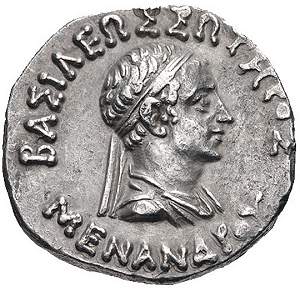 | 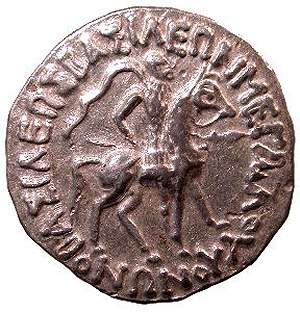 | 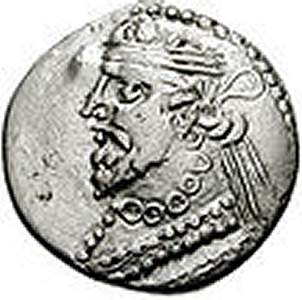 |
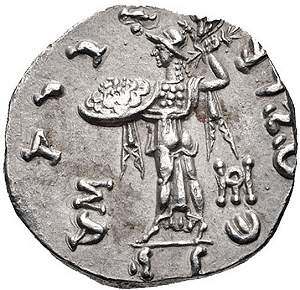 | 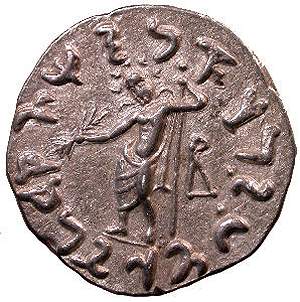 | 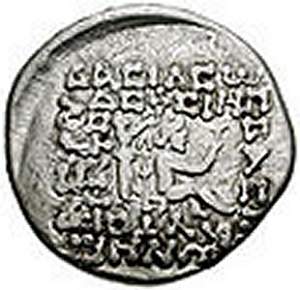 |
Indo-Greeks Menander I Soter c. 155-130 BC. Ar Tetradrachm 24mm, 9.93 g. Obverse: diademed and draped bust right. Reverse: Athena Alkidemos left; Σ to left, monogram to right. (Bopearachchi Serie 12A; SNG ANS 764-7.) | Indo-Scythians. Vonones, with Spalahores, c. 75-60 BC. Ar tetradrachm. Obverse: BASILEWS BASILEWN MEGALOU VONONOU. King on horseback riding right, in cataphractus & carrying a whip & lowered spear . Reverse: Zeus standing facing, holding long spear & thunderbolt, monogram under left arm, in Kharosthi script Spalahoraputrasa Dhramiasa Spalahorasa, or Spalagadames son of Spalahores. ( Senior-65.3, M-681) | Indo-Parthians. Gondophares (20-10 BC) 3.34 g. Obverse: diademed bust facing left. Reverse: Gondophares seated facing right, Nike behind. Legend around in blundered Greek: possibly originally BASILEOS SOTEROS UNDOPhERROU (king saviour Gondophares) |
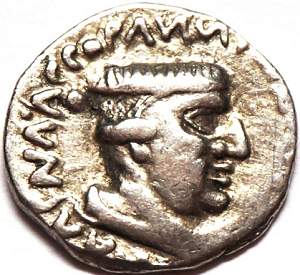 | 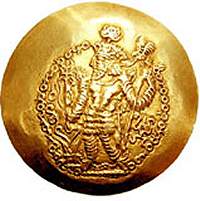 |  |
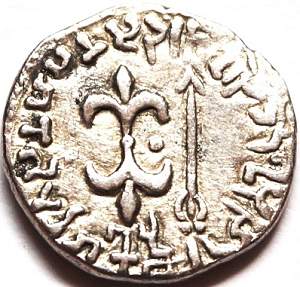 | 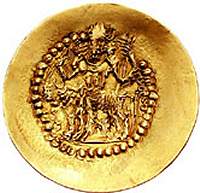 | 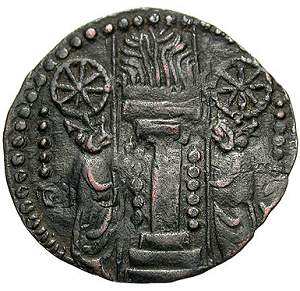 |
Western Kshatrapas, Nahapana (r. c. 53-99 AD) Ar drachm 16 mm 2.22 g. Obverse: King's bust right, with Greek legend around. Reverse: Stylized thunderbolt and arrow, with Brahmi legend Rajno Kshaharatasa Napanasa on left margin and Kharoshthi legend Rajno Chaharatasa Nahapanasa on right margin. (Senior 303) | Indo-Sasanids (Kushanshas) Varhran I (early 4th century). Obverse: King Varhran I with characteristic Indus Valley head-dress. Reverse: Iranian bull (and a Zoroastrian fire altar in some issues) | Nezak Huns, Napki Malka, Ae drachm. 7th Century AD. Kabul- Zabul area. 25mm x 26mm, 3.43g. Obverse: Bust of 'Napki' type wearing winged- headdress surmounted by bull's head right. Reverse: altar with attendants with large wheels on their heads.(Göbl 222; Mitchener 1510) |
References and Further Reading
Need the 74 references and 13 illustration sources? Please consider the inexpensive ebook.

